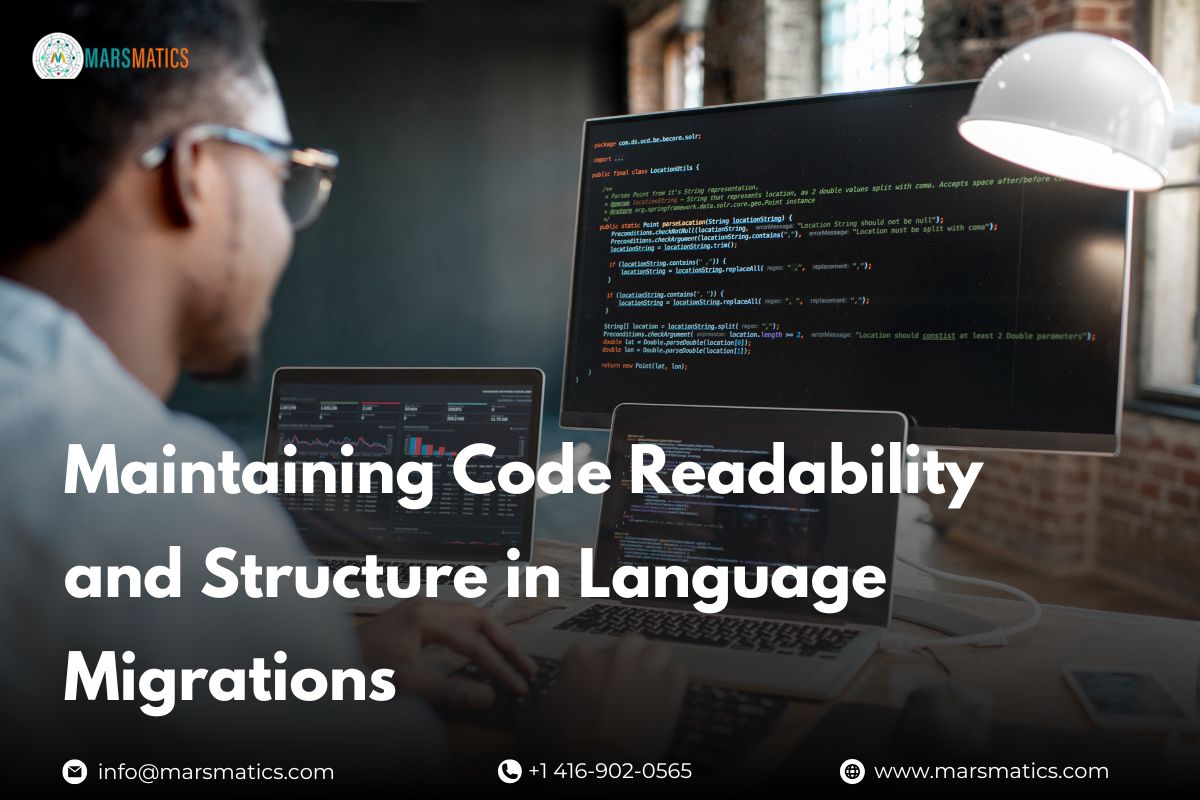Maintaining Code Readability and Structure in Language Migrations
When migrating code from one programming language to another, it’s easy to focus only on functionality: “Does the code run?” But successful migrations require more than compiling — they demand code readability in language migration. Why? Because unreadable code leads to higher technical debt, frustrated developers, and costly bugs down the road.
In this blog, we’ll break down why readability and structure are essential in migration projects, the common pitfalls to avoid, and the tools for maintaining code readability that keep your project future-proof.
Why Code Readability Is Critical in Language Migrations?
Language migrations often involve large teams and complex systems. Without readability and structure, even a working migration can become a nightmare to maintain.
- Readability ensures easier collaboration and onboarding. When multiple developers are working on the same codebase, clear and consistent code reduces confusion.
- Structured code reduces bugs during migration. Organized logic flows make it easier to catch errors before they multiply.
- Long-term benefits. Prioritizing code maintainability standards during migration lowers technical debt and speeds up debugging cycles.
Simply put, code readability in language migration isn’t a luxury — it’s a requirement.
Also Read: Advanced C# Features During VB.NET Conversion
Common Pitfalls That Hurt Readability During Migration:
Even seasoned teams fall into traps that reduce readability:
- Inconsistent naming conventions across languages. Migrating without a naming guideline leads to confusion and inconsistency.
- Overusing automated converters without review. Converters may handle syntax but often ignore formatting, documentation, and structural clarity.
- Ignoring indentation, spacing, and formatting rules. Small differences pile up into major readability issues.
- Mixing legacy and new code without proper documentation. When developers can’t distinguish old logic from migrated logic, maintainability suffers.
Preserving Code Structure Across Different Languages:
Preserving structure is about keeping the “skeleton” of your application intact:
- Mapping classes, methods, and namespaces. Ensure naming maps cleanly from the source to the target language.
- Handling indentation and whitespace differences. Seemingly minor, but crucial for clean code reviews.
- Keeping architecture layers intact. UI, business logic, and data access should remain clearly separated.
- Design patterns. Using patterns consistently across languages ensures smoother scaling.
If you want to maintain code structure during migration, documenting these mappings upfront will save endless headaches.
Also Read: C# to Vb.net – Best Code Converting Tools
Best Practices for Maintaining Readability During Conversion
Migrating code is an opportunity to improve — not just replicate.
- Establish coding standards early. Before migration begins, define code maintainability standards and enforce them.
- Leverage automated formatters. Prettier, ESLint, or StyleCop enforce consistency during conversion.
- Review and refactor. Automated tools get you 70% there, but manual code refactoring after migration ensures clarity and performance.
- Document as you go. Maintain structured documentation for future developers.
Tools and Frameworks That Help Preserve Structure:
Without the right tools, maintaining readability is nearly impossible.
- Code style analyzers. SonarQube, StyleCop, and PMD enforce style rules and highlight problem areas.
- Automated migration tools with readability checks. These catch common pitfalls like spacing and inconsistent casing.
- Version control hooks. Pre-commit hooks can enforce style before code merges.
- IDE extensions. Tools like ReSharper or Roslyn analyzers help enforce rules in real time.
For teams, investing in tools for maintaining code readability is one of the smartest long-term moves you can make.
Testing and Validation for Readability and Structure:
Readability isn’t subjective if you measure it. Testing validates structure just as much as functionality.
- Code reviews as a quality gate. Human eyes spot inconsistencies tools may miss.
- Static analysis. Tools catch formatting, indentation, and unused code.
- Automated formatting in CI/CD. Enforce standards every time code is pushed.
- Peer testing. Developers should validate whether migrated code is understandable at first glance.
Long-Term Strategies for Readable Code After Migration:
Migration isn’t the finish line — it’s the beginning of a new lifecycle.
- Continuous training. Developers need to stay fluent in the target language’s style.
- Regular audits. Schedule periodic readability audits to prevent drift.
- Documentation-driven development. Use docs as a foundation for clarity.
- Build culture. Make clean code part of the team’s DNA, not just a rule.
This way, code refactoring after migration doesn’t become a one-time event but an ongoing practice.
Conclusion:
Code readability in language migration isn’t about pretty formatting — it’s about maintainability, collaboration, and long-term success. From establishing standards to using the right tools for maintaining code readability, every step in migration should emphasize clarity.
When you maintain code structure during migration and commit to continuous code refactoring after migration, you future-proof your applications against technical debt. Treat readability as a core goal, not an afterthought, and your migration will deliver value far beyond functionality.
FAQs
Why does code readability often suffer during language migration?
Because automated tools focus on syntax, not style, leading to messy formatting, inconsistent naming, and harder-to-maintain code.
How can I maintain consistent naming conventions across languages?
Create a naming guideline before migration and apply automated linters or style checkers to enforce it throughout the project.
Are automated code converters enough to ensure readable structure?
No. While converters handle syntax, developers must review and refactor code for clarity, readability, and maintainability.
What’s the best way to validate code readability post-migration?
Conduct code reviews, run static analysis, and involve peers to assess readability and structure before deploying migrated code.








